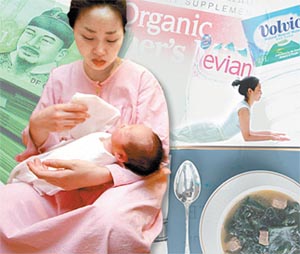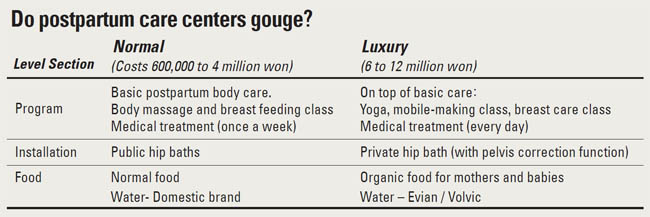After love’s labor, new moms want a five-star recovery

But then he started scouting for a postpartum care center, or sanhujoriwon, and the joy shriveled away. He called a center in Gangnam District but hung up after hearing the price: six million won ($5,190) for a two week postpartum course of treatment.
Kang’s wife had a better idea: for the same money, they could make a reservation at a center in Samseong-dong, southern Seoul, which has gained fame because it has used by celebrities, including Go So-young, a top actress.
Kang and his wife took a tour. The rooms were like those in a luxury hotel and the treatments included massages, skin care and a full spa.
“I was strongly determined that I wouldn’t spend that much money for a two week program,” Kang said. “But my wife said it might be a one-time event in our family, as we’ve planned to have only one baby. I had to make a reservation.”
In Korean tradition, women who have given birth shouldn’t exert themselves and are pampered in various ways. In the old days, the women would recover at their parents’ house, drink seaweed soup and bundle up, even in the summertime.
In modern Korea, clinics have arisen to substitute for a mother’s care, and they offer traditional postpartum care, called sanhujori - but for a price. And Kang isn’t paying anywhere near the top of the scale for the clinics. Some charge 12 million won for two weeks of pampering.

The cheapest center, which cost 660,000 won, is located in Jeonju, North Jeolla, and the most expensive center, which cost 12 million won, is in Dogok-dong, southern Seoul.
“More than 200 postpartum care centers are located in Seoul and Gyeonggi and most of them are more expensive than in rural areas,” said professor Seo Young-joon at Yonsei University’s Medical Welfare Research Center. “In Seoul and Gyeonggi, the average cost gets increased by at least one million won.”
“The postpartum care centers have become more popular because Korean families have become more nuclearized in the last decade,” said Kim Jin-sil, the chairwoman of Social Trend Institute. “Traditionally, mothers or mothers-in-law took care of the postpartum care but the care centers have taken the role with more professionalism in diverse areas, including postpartum depression.”
Young parents don’t hesitate to spend the money compared with their parents’ generation, Kim said, because they only have one or two children.
But in fact, some young couples are hesitating. According to a survey of 2,500 Seoul citizens aged between 25 and 44 by the Seoul Foundation of Women and Family, about 68.6 percent of the participants said that they were delaying having a baby or not having one because of the costs involved. A little more than 40 percent of that group said they were worried specifically about the initial birth expenses, including hospital bills, postpartum care and buying baby supplies. (The remaining 28 percent of the group said they were delaying having a baby or not having one because schooling fees were too expensive for them.)
“It cost about 8 million won for me,” said 31-year-old Yeom Je-il, whose wife delivered a baby boy last month. “I’ve spent about two million won for the hospital fee, four million won for the postpartum care and about two million won for baby products. The money went out within a month.”
Yeom and his wife used a postpartum center in Nowon district, northern Seoul.
“I’ve also visited expensive centers in southern Seoul and they cost at an average of five to seven million won, which I couldn’t afford,” Yeom said. “I still feel sorry for my wife though.”
Banker Kang is booked into one of the high-priced centers and witnessed what it had to offer before he made his wife’s reservation at the Samseong-dong facility.
A consultant cited two key features that differentiated luxury care centers from standard sanhujoriwon. First, they only hire licensed nurses, not nursing auxiliaries. Second, pediatricians stay in the center and give medical treatment every day. In standard or low-priced centers, the consultant said, many nurses aren’t licensed and doctor visit once a week.
Each room offers a bed, a cot for the husband, a private bathroom and entertainment equipment like PCs and televisions.
They also have hip baths that help with the cleaning of the mother’s perineum region, which the center emphasizes, and pelvis correction, which is a common procedure in Korea.
In inexpensive centers, the baths are shared and don’t have a pelvis correction function, the consultant said.
If a couple chooses the 12 million won package, all the products for mother and a baby are imported. The water is Evian or Volvic from France, and the diapers are organic to protect the baby’s skin. The room is bigger, and the food becomes all organic.
Mother have two to three classes per day including yoga, postpartum body care, baby massage class and breast-feeding class. It is up to mothers whether they participate in these classes or not but the price doesn’t get discounted.
“I visited inexpensive centers in northern Seoul, which cost an average of two to three million won, but I wasn’t satisfied with their quality,” Kang said. “They rooms were small, they didn’t have windows, and only one pediatrician was taking care of more than 20 mothers and their babies.”
Sanhujoriwon have become a cultural phenomenon and a thriving business, but the government shows no interest in regulating the centers.
“We’ve conducted research on fees of more than 400 postpartum care centers in the country,” an official in the welfare ministry said. “But as far as we know, there is no movement to regulate them.”
“Currently, these centers are registered as service businesses like restaurants, not medical institutions,” said Shim Mi-young, a professor at the International University of Korea. “That means that they can frequently change their programs and their fees.”
By Kwon Sang-soo [sakwon80@joongang.co.kr]










with the Korea JoongAng Daily
To write comments, please log in to one of the accounts.
Standards Board Policy (0/250자)